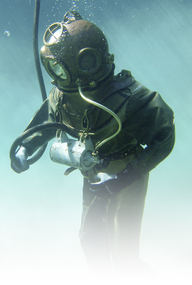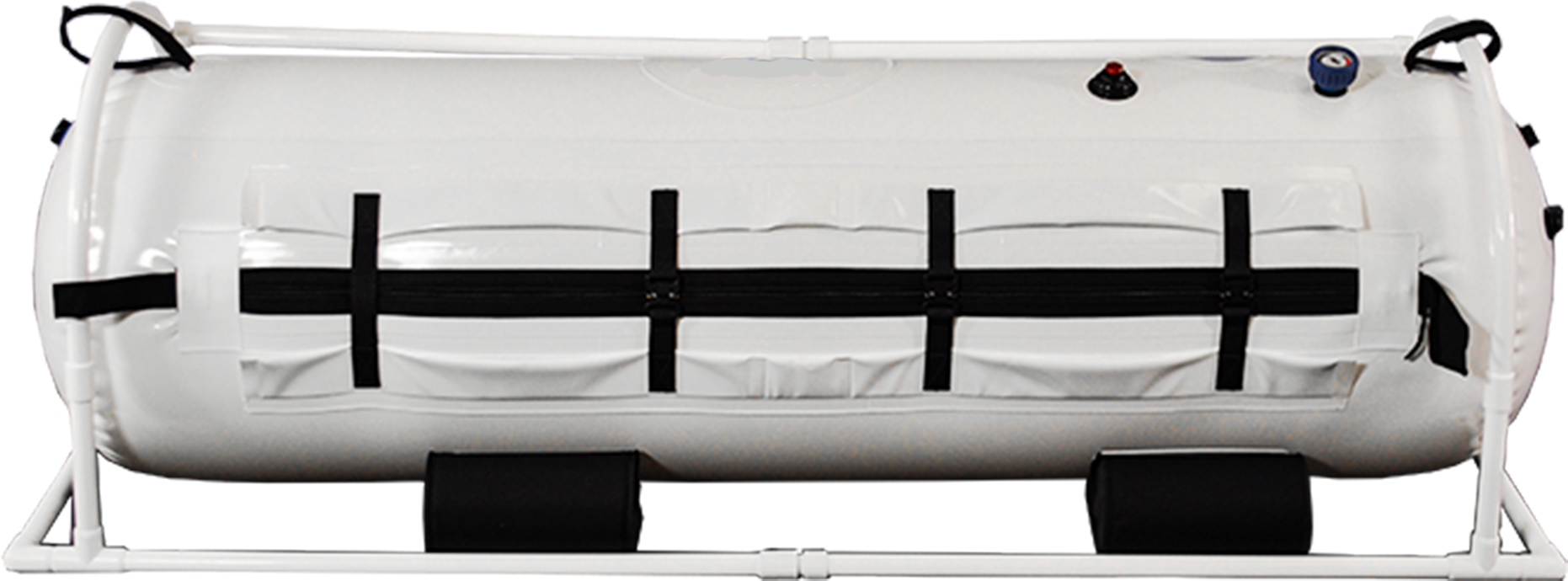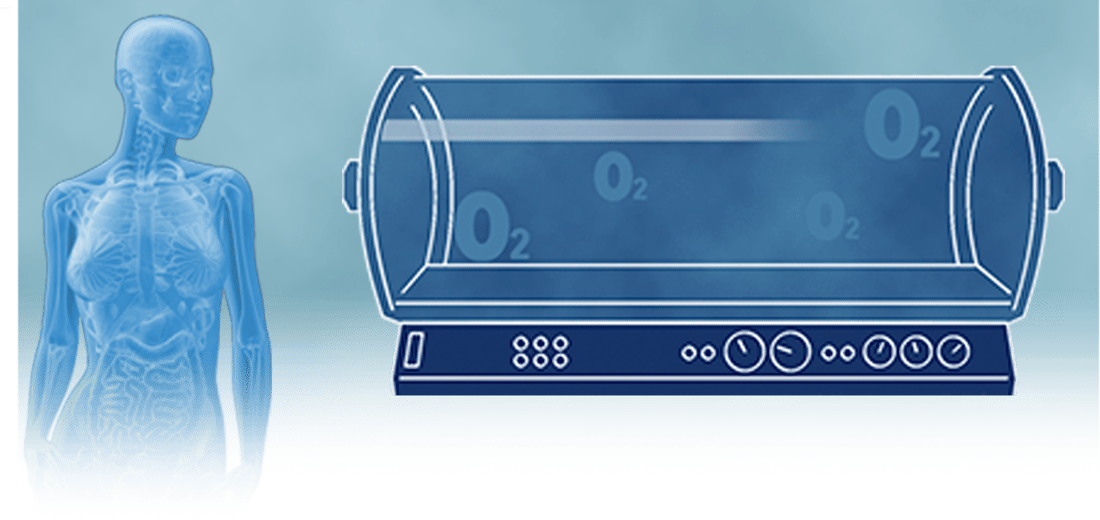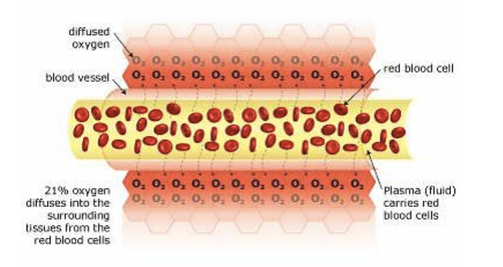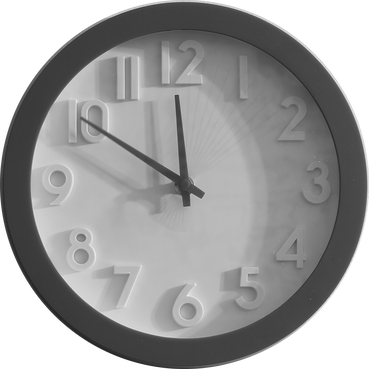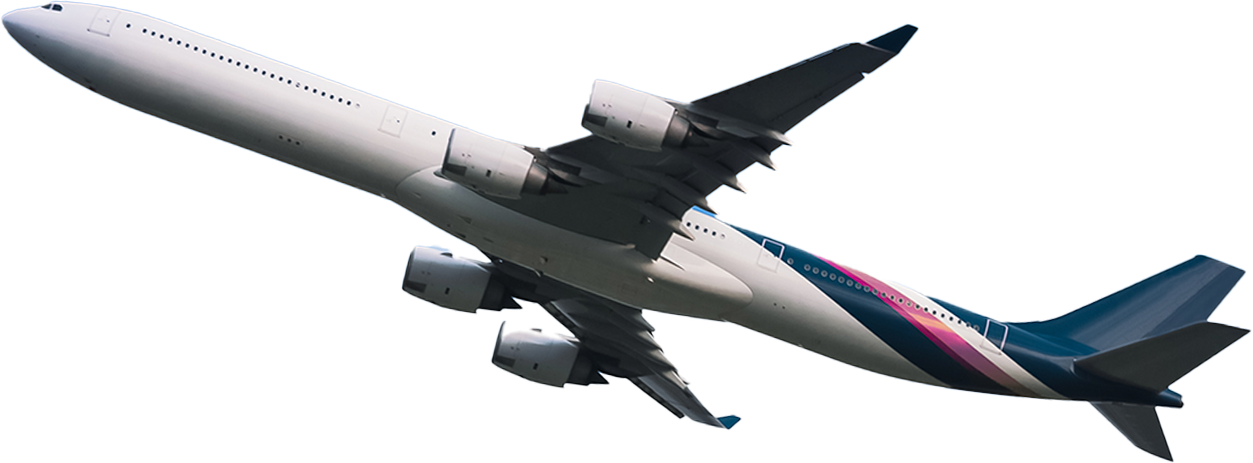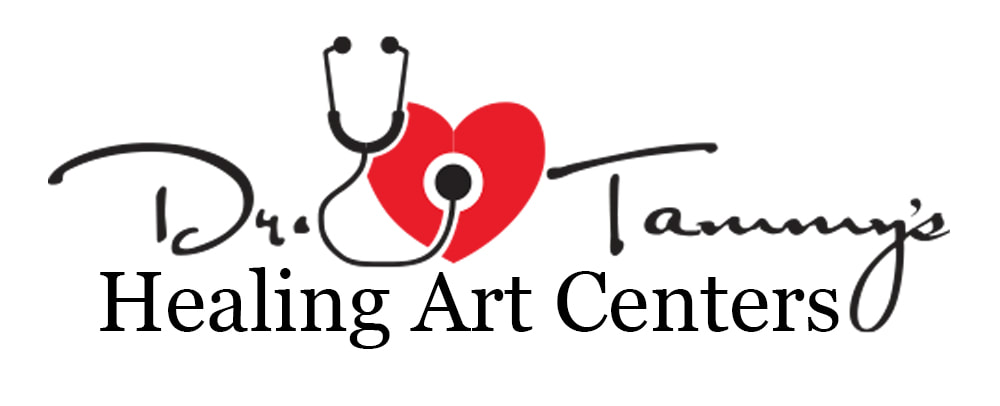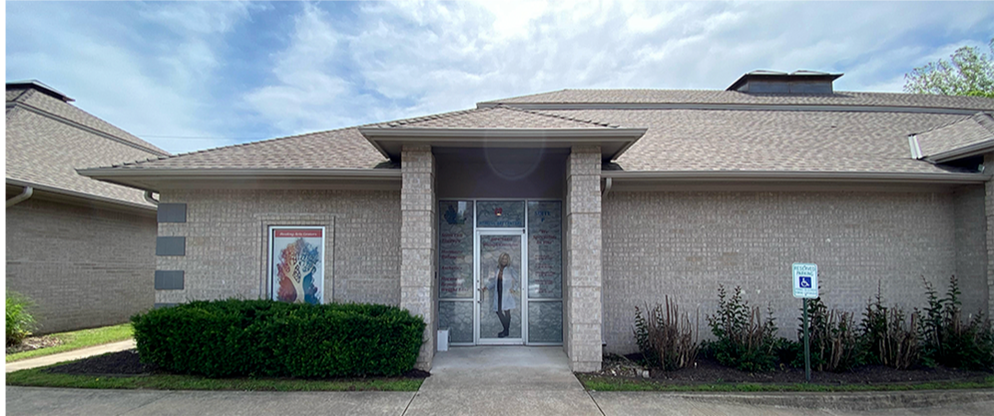Hyperbaric oxygen therapy has been used to treat many of these conditions. It is FDA approved in certain conditions such as wound healing.
Hyperbaric medicine is a medical treatment in which an ambient pressure greater than sea level atmospheric pressure forces oxygen into the cells of the body. Hyperbaric oxygen therapy (HBOT) has many indications and has been used healing of many types. Our clinic uses HBOT with stem cell regenerative therapy to enhance the effectiveness. A study done in 2005 showed that HBOT increases stem cell activity 8 fold after 20 treatments.
Hyperbaric therapy was originally used to treat deep sea divers who were thought to be suffering from the formation of air embolisms due to a too rapid ascent from their deep sea dive. Many people have said that the hyperbaric chamber looks like a small submarine
Hyperbaric medicine is a medical treatment in which an ambient pressure greater than sea level atmospheric pressure forces oxygen into the cells of the body. Hyperbaric oxygen therapy (HBOT) has many indications and has been used healing of many types. Our clinic uses HBOT with stem cell regenerative therapy to enhance the effectiveness. A study done in 2005 showed that HBOT increases stem cell activity 8 fold after 20 treatments.
Hyperbaric therapy was originally used to treat deep sea divers who were thought to be suffering from the formation of air embolisms due to a too rapid ascent from their deep sea dive. Many people have said that the hyperbaric chamber looks like a small submarine
It is a firm shelled pressure vessel (when expanded) made of welded thermoplastic polyurethane (TPU), kevlar and aluminum with view ports (windows) made of acrylic. The chamber has a human entry hatch, an airtight door to the hatch, and a mattress pad to lie on so that the patient can comfortably lie in the chamber and nap or read.
The nurse is visible through the view port. Our two-way intercom allows the technician to stay in constant communication with the patient. The patient is then instructed to put on an oxygen mask and the technician will adjust it properly. Ninety nine to one hundred percent pure O2 is flowing in. The “dive” (as it is called in HBOT therapy) is just about to begin!
Now special valves are opened to let in pressured air. Normal room air is (at sea level) about 15 pounds per square inch. This is called “one atmosphere absolute.” We abbreviate that as 1 ATA.
Now special valves are opened to let in pressured air. Normal room air is (at sea level) about 15 pounds per square inch. This is called “one atmosphere absolute.” We abbreviate that as 1 ATA.
Most hyperbaric oxygen treatments take you down to 2 ATA or about 30 pounds per square inch. That’s about the same amount of pressure as in the tires of a car. The patient is reminded to swallow. Once the patient does, the air pressure equalizes and they can hear better. (Some patients with chronic ear congestion require special coaching in order to comfortably reach a depth of 2 ATA).
Once the patient’s time is up, the “ascent” to the surface pressure of 1 ATA begins. It takes about 10 minutes to slowly and safely return to 1 ATA, all the while the patient continues to swallow to clear their ears!
Once the patient’s time is up, the “ascent” to the surface pressure of 1 ATA begins. It takes about 10 minutes to slowly and safely return to 1 ATA, all the while the patient continues to swallow to clear their ears!
The increased air pressure, combined with an increase in oxygen to up to 100 percent, forces oxygen to dissolve in the liquid part of a person’s blood. This “hyper-oxygenated” blood is delivered to all of the body’s cells, tissues, and fluids at up to 10 times over the normal concentration! This is high enough to sustain life with no blood at all!
Let’s do the calculation: Room air is 20% oxygen. So 100% oxygen is an increase of 5 times. Then if this is done in 2 ATA (which is double the air pressure) this DOUBLES the effect of the 100% oxygen. The net result is that the body experiences a 10-fold increase in oxygen to the cells! Wow!
Let’s do the calculation: Room air is 20% oxygen. So 100% oxygen is an increase of 5 times. Then if this is done in 2 ATA (which is double the air pressure) this DOUBLES the effect of the 100% oxygen. The net result is that the body experiences a 10-fold increase in oxygen to the cells! Wow!
Here are just some of the many amazing benefits that Hyperbaric Oxygen Chamber Therapy has been shown to provide:
- Greatly increased oxygen concentration in all body tissues, even with reduced or blocked blood flow.
- Stimulation of the growth of new blood vessels to locations with reduced circulation, improving blood flow to areas with arterial blockage (such as after a stroke or a head injury.)
- Rebound arterial dilation, resulting in an increased blood vessel diameter greater than when therapy began, improving blood flow to compromised organs.
- An adaptive increase in superoxide dismutase (SOD), one of the body’s principal, internally produced antioxidants and free radical scavengers.
- Greatly enhanced white blood cell action, thus allowing your immune system to eliminate stubborn chronic infections.
- Stimulation of the release of adult stem cells that promote tissue regeneration and healing.
The use of increased atmospheric pressure for medical therapy has intrigued many physicians and scientists for hundreds of years.
Though not new, HBOT has recently gained importance for treatment of chronic degenerative health problems related to atherosclerosis, stroke, peripheral vascular disease, diabetic ulcers, wound healing, cerebral palsy, brain injury, multiple sclerosis, macular degeneration, and many other disorders.
Wherever blood flow and oxygen delivery to vital organs is reduced, their functioning can be improved with HBOT.
When the brain is injured by stroke, cerebral palsy, or trauma, then HBOT may re-activate the stunned parts of the brain to restore function. Results can be dramatic. Patients with cerebral vascular disease commonly recover from complications of stroke more readily after HBOT.
This is also true for potentially gangrenous legs and feet caused by blocked circulation, and for slow healing diabetic ulcers. HBOT relieves pain, helps fight infection, and keeps threatened tissues alive.
Though not new, HBOT has recently gained importance for treatment of chronic degenerative health problems related to atherosclerosis, stroke, peripheral vascular disease, diabetic ulcers, wound healing, cerebral palsy, brain injury, multiple sclerosis, macular degeneration, and many other disorders.
Wherever blood flow and oxygen delivery to vital organs is reduced, their functioning can be improved with HBOT.
When the brain is injured by stroke, cerebral palsy, or trauma, then HBOT may re-activate the stunned parts of the brain to restore function. Results can be dramatic. Patients with cerebral vascular disease commonly recover from complications of stroke more readily after HBOT.
This is also true for potentially gangrenous legs and feet caused by blocked circulation, and for slow healing diabetic ulcers. HBOT relieves pain, helps fight infection, and keeps threatened tissues alive.
These benefits do not happen in just one treatment. A series of treatments are required. Before entering the pressurized oxygenated room or tube, here’s some things you can expect:
We call our treatments ‘dives’ because our chamber is pressurized to 2.2 ATA (atmospheres absolute), which is the equivalent of scuba diving down 40 feet of seawater. It’s a unique treatment that not many people know about.
When body tissue is injured, it may require more oxygen to heal. Hyperbaric oxygen therapy involves breathing in oxygen at a high pressure to help fight infection and induce wound healing.
The pressurization and oxygen hoods are the most important aspects of the therapy. The mask increase the oxygen that your lungs take in, and the pressurization increases the amount of oxygen your blood absorbs. This delivers more oxygen to parts of the body where it may be in short supply. The extra oxygen can assist with healing, fighting infection and has also been shown to stimulate the release of stem cells and growth factors.
The increased atmospheric pressure, along with the patient receiving 100% oxygen through the hood, allows both your blood and blood plasma to carry oxygen more effectively. This saturates the body with oxygen and improves the body’s effectiveness in healing wounds, concentrating stem cells or improving many different medical conditions. We treat patients with a variety of diagnoses in our chamber, but each indication is backed up by scientific research and endorsed by experts in the field.
Hyperbaric medicine has been done for a long, long time. The first treatment was done in the 1930s by the U.S. Navy for decompression sickness. Treatments have been performed in healthcare settings since the 1950s or 1960s.
We call our treatments ‘dives’ because our chamber is pressurized to 2.2 ATA (atmospheres absolute), which is the equivalent of scuba diving down 40 feet of seawater. It’s a unique treatment that not many people know about.
When body tissue is injured, it may require more oxygen to heal. Hyperbaric oxygen therapy involves breathing in oxygen at a high pressure to help fight infection and induce wound healing.
The pressurization and oxygen hoods are the most important aspects of the therapy. The mask increase the oxygen that your lungs take in, and the pressurization increases the amount of oxygen your blood absorbs. This delivers more oxygen to parts of the body where it may be in short supply. The extra oxygen can assist with healing, fighting infection and has also been shown to stimulate the release of stem cells and growth factors.
The increased atmospheric pressure, along with the patient receiving 100% oxygen through the hood, allows both your blood and blood plasma to carry oxygen more effectively. This saturates the body with oxygen and improves the body’s effectiveness in healing wounds, concentrating stem cells or improving many different medical conditions. We treat patients with a variety of diagnoses in our chamber, but each indication is backed up by scientific research and endorsed by experts in the field.
Hyperbaric medicine has been done for a long, long time. The first treatment was done in the 1930s by the U.S. Navy for decompression sickness. Treatments have been performed in healthcare settings since the 1950s or 1960s.
|
1. Don't arrive sick to the
appointments. Your treatment might be delayed if you have a cold or other illness such as high blood pressure, fever, frequent loose stools or any flu-like symptoms. If a patient has a cold, it could affect their ability to clear their ears, which could lead to inner ear injury. |





